Tips For Trainers, By Trainers: Working With Kids
Blog Content Tips for Trainers // March 09, 2016
We spoke with a few GYROTONIC® and GYROKINESIS® Trainers about how they teach the methods to younger children and teens. Whether you regularly work with kids, or haven’t had the opportunity yet, these tips and suggestions can improve your comfort level and effectiveness when it comes to working with this age group.
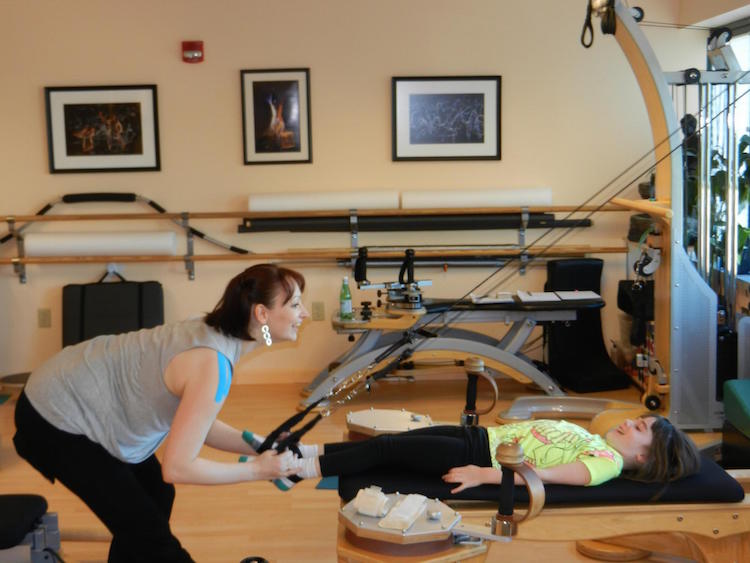
Photo provided by Veronique Breen
Veronique Breen
GYROTONIC® Master Trainer and GYROKINESIS® Pre-Trainer
Motion Arts at the Detroit Skating Club
Bloomfield Hills, Michigan
email: info@motionartspt.com
http://www.motionartspt.com/home.html
Not everyone is able to work with kids. You need to have a certain comfort level, or still be a kid at heart.
When teaching the Gyrotonic Method to teens and younger kids, it can be a challenge to make sure they are able to fit on the equipment. I work with young skaters, and sometimes they are really small for their age. Using a stepper or foam under their feet is always helpful.
A young person’s abdominal control is not yet fully developed. So getting them into hamstring series, without having them fly away (which can also be fun!), means using low weights and sometimes a belt to hold them to the bench.
I often have to find different ways to explain what they need to feel in their bodies, allowing them to find their own images and have fun, while keeping control of their growing bodies.
Teaching the Gyrokinesis Method can also be a lot of fun with kids. They can really relate to the animals and go beyond where adults are comfortable. For example: Arch and curl in happy cat and sad cat; jump or bounce like a kangaroo on the ball; swing the arms around for spiral in spinal motion with monkey arms; and elongate the neck like a giraffe. I add emotions to them to make them move faster (happy) to slower (sad) to having more power (angry).
The seated part can sometimes be boring for younger kids so I allow them to be on a balance ball which keeps them interested and makes bouncing a natural way to narrow.
For me it is a very fun group to work with, but it keeps me on my toes and forces me to think outside the box. Working with kids is a great way to stay creative!
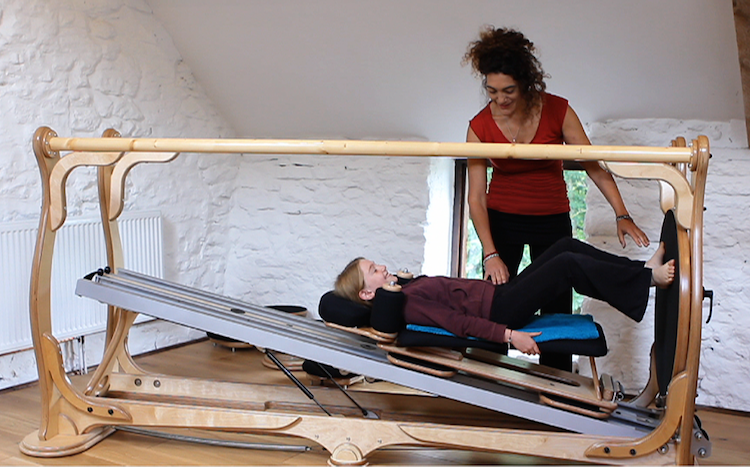
Photo provided by Leda Franklin
Leda Franklin
GYROTONIC® and GYROKINESIS® Master Trainer
GYROTONIC® In the Fields
Horsley, Stroud
United Kingdom
“Working with children in the Gyrotonic Expansion System Method” is a sentence that does not make sense. It doesn’t make sense because we do not ‘work’ with them; we ‘play’ with them. Juliu Horvath has always said we should not ‘work out’ but we should ‘play in.’ Children remind us how to do this, quite simply. In fact, children show us the way in which we should all move in this system.
Children follow their instincts and curiosity. Their play naturally utilizes their whole body in all the ways we are supposed to move and grow: climbing, hanging, twisting, arching, rolling, balancing and centering.
A child’s attitude toward movement is also the manner in which all things should be done: laughing, trying, stopping, changing, trying again, doing something else, going back to the beginning.
Because our ‘education system’ teaches children to not follow their instincts, to work in boxes for fixed amounts of time, to follow rules and ‘do what is expected,’ children lose their ability to play. Both the Gyrotonic and Gyrokinesis Methods are a wonderful way to help children (and adults) get instinct, play, movement and joy back into their bodies on the most fundamental and internal level. The methods encourage curiosity of what your body can and cannot do.
These methods work deeply on our nervous systems, as well as all the other functions of our bodies. As we all know, too often these days children cannot, or do not, use their bodies for play. Therefore, they do not do enough lengthening, strengthening or twisting movements in their spine; they do not stimulate their internal organs or develop their flexibility and coordination.
When l work with children I approach their session as a time of play. We usually start with some hamstring sequences, because what child does not like to swing around by their legs and wave them around. I teach them small amounts of form and direction. But l also let them have fun and wiggle around and find out at what point the pulleys will take them off the bench. And we count only for fun, not to repeat a set number of anything.
We pretend to be animals and make funny noises. My children call the ‘arch and curl with diving pattern’ the ‘flying hamster.’ I have no idea why, but we like it, and pretending to be a flying hamster makes them want to do many of them.
If a child is training in something seriously, such as dance or a sport, I will ask them what they like about it and what they would like to be easier to do. This is just as one would do with an adult. We then focus more on these aspects in their session. Find the ease, not the work. Let them jump!
Most of the time children need to do arch and curl on their knees, as the equipment does not accommodate their smallness. But this is my preferred position for arch and curl sequences anyway. It utilizes more of the spine and involves more leg movement and abdominal connection, if you allow them to move up and down off their knees. This is the original manner in which arch and curl was taught. Sitting only came to be because many people cannot kneel comfortably.
Most children do not have very long attention spans, so do not expect them to be able to focus on a ‘session’. Four times arching forward may be all they can do that day. Great! Leave it alone and do something else. Change exercises every time you feel a flicker of boredom.
Do not expect understanding or achievement; find joy and feel good. There is no importance in exercise if it is not fun. However necessary movement is, the body will not grow in a healthy way if it is stressed and bored. When exercise is fun, the body will grow, change, learn, and excel. This is the point for all people, big or small, child or adult. The Gyrotonic Expansion System Method is a game to enjoy and explore. Maybe you will surprise yourself by where you end up when you have fun without a desired result in all your movement!
Finally, remember that the secret to working with children is to remember you still are one, even if you have forgotten the fun parts.
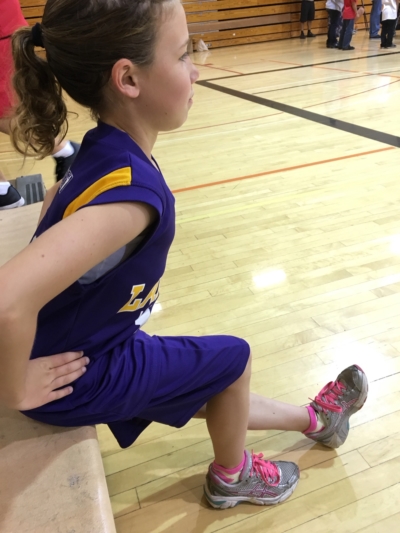
Photo provided by Donna Place
Donna Place
GYROTONIC® Master Trainer, GYROKINESIS®Pre Trainer
Orange County GYROTONIC®
Huntington Beach, California
email: donnaplace@socal.rr.com
Working with young people can be hilarious, rewarding and challenging. Here are some tips:
Do your homework.
Researching what skills are age appropriate is essential. Especially in children under 6, the skill levels, attention spans, and endurance abilities change dramatically from year to year.
Getting familiar with how exercise affects growth plates and joint formation is also important. It is helpful to finding a child development person, physical therapist or physician in your area that can be a resource.
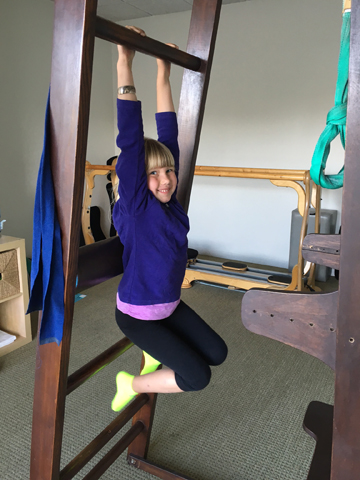
Photo provided by Donna Place
Go to them.
Bringing Gyrokinesis to a basketball team, pre-school, ballet class, etc. is often much more effective than trying to start a kids’ class in the studio. Those students will already be grouped according to age, skill level or interest, and the tightness or imbalance issues will be a bit more uniform. You will also have some backup from the coaches or teachers.
Be playful.
Don’t forget that movement should be fun. Find imagery that works for your group. If something is not working move on and find a better way to approach it next time. Be creative with discipline and have a plan in place before you start. Have fun!
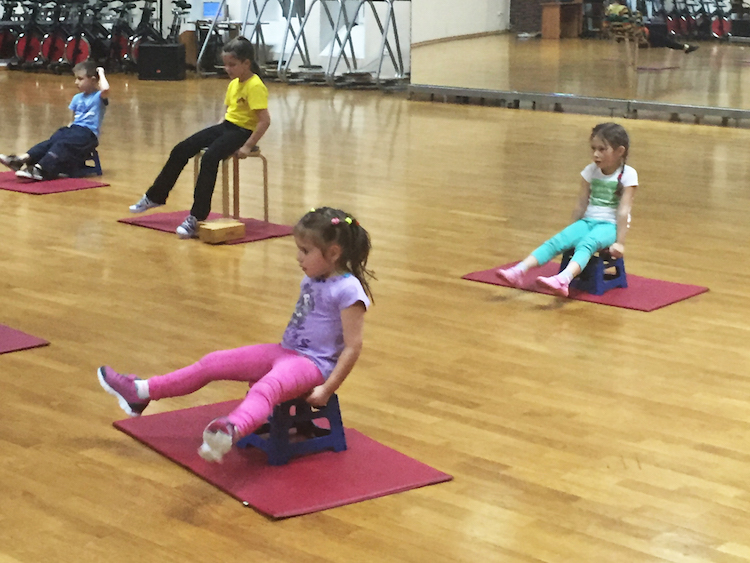
Photo provided by Victoria Savelieva
Victoria Savelyeva
GYROTONIC® and GYROKINESIS® Master Trainer
Academy GYROTONIC®
St. Petersburg, Russia
e-mail: valviksav@yandex.ru
www.gyrotonic-academy.ru
I started my career in sports when I was 6 years old and went all the way to becoming an Acrobatic Gymnastics World Champion. When I walked away from professional sports, I focused on working with children in sports schools. While coaching children to help them achieve in sports, I always kept in mind that sports can have both positive and negative impacts on young athletes.
Sixteen years ago I discovered the Gyrotonic Expansion System Method. Later, I become a Gyrotonic and Gyrokinesis Master Trainer, as well as Master Trainer specializing in other additional programs and equipment.
With a background in coaching children, I kept thinking about how the Gyrotonic and Gyrokinesis Methods could add value to the physical education of children, who are our future. Two years ago, I realized a way that this whole system could be integrated into a training program for children. After consulting with Juliu, I got the go ahead to develop a course for children, and so the creative process began.
When working with children you have to understand that it is not only about developing certain physical and psychological capacities in children, but it is also a consistent process of working with their parents as well.
If a kid loves going to your training classes but the parents are not willing to take them to your classes, then there is a good chance you will not see this kid again. The same is true when parents love your classes, but the kid dislikes them; one day the parents will get tired of persuading them to go to the training classes and they will quit.
With this in mind, we designed a unique set of animal-inspired exercises. Since kids have excellent imaginations, and have fun imitating animals, many familiar exercises have been renamed, e.g. arch and curl is called White Black Swan. Doing this enables them to perform even complex exercises easily. It is a fairy land where children can turn into bears, flamingos, lizards and other animals with a twist.
Kids love being part of the Wonders In the Zoo. This program has proved a success when introduced in a private kindergarten. Certified Gyrokinesis trainers are welcome to enroll in the course to discover new possibilities.
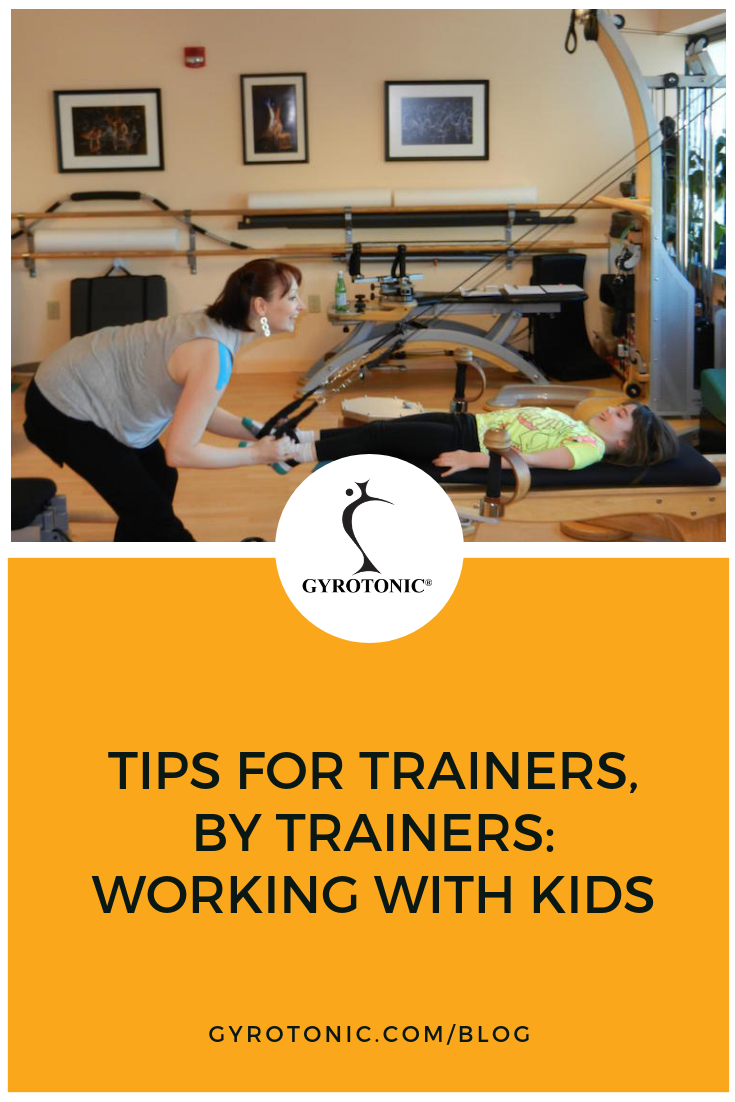
Pin for later!
